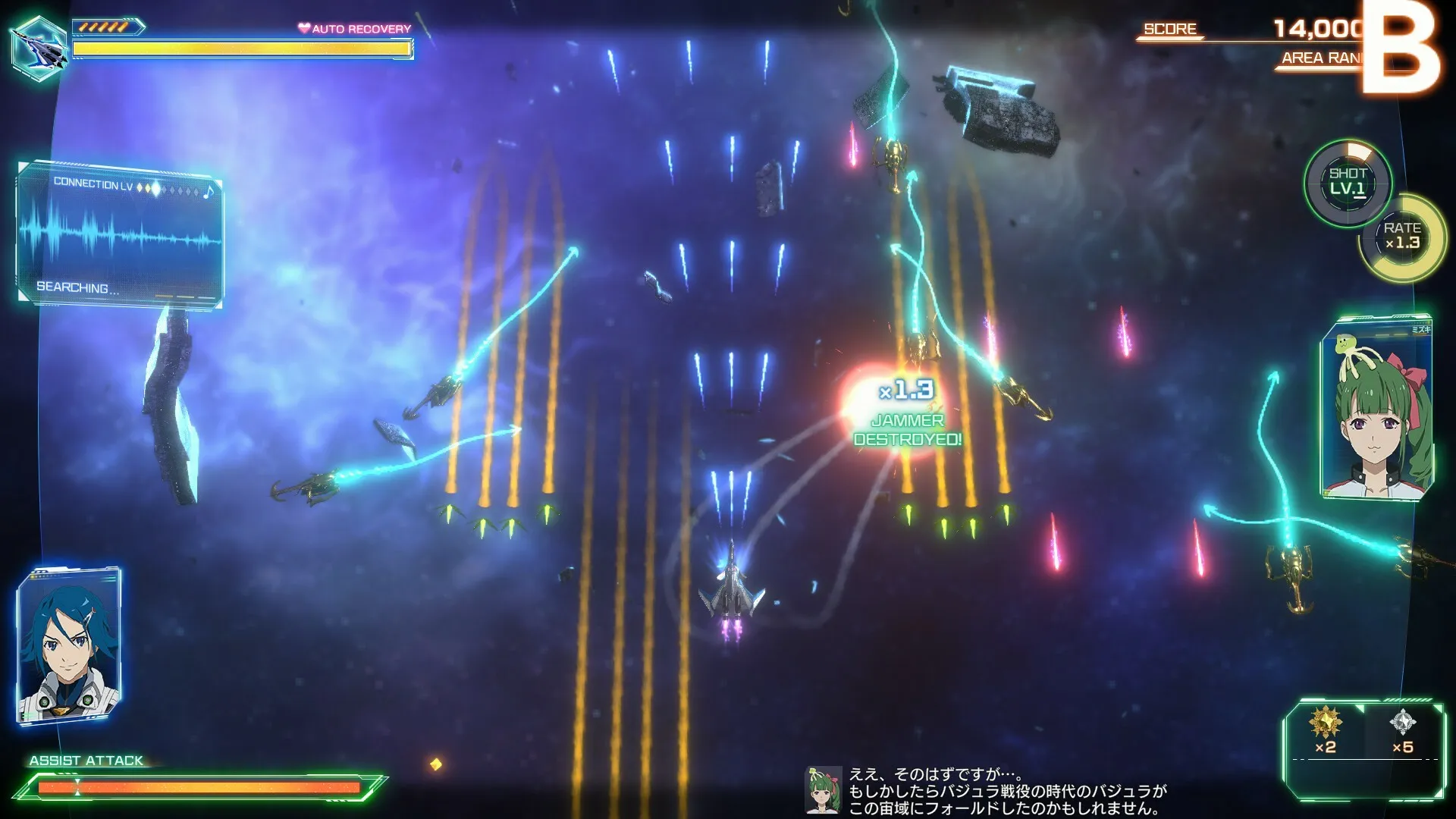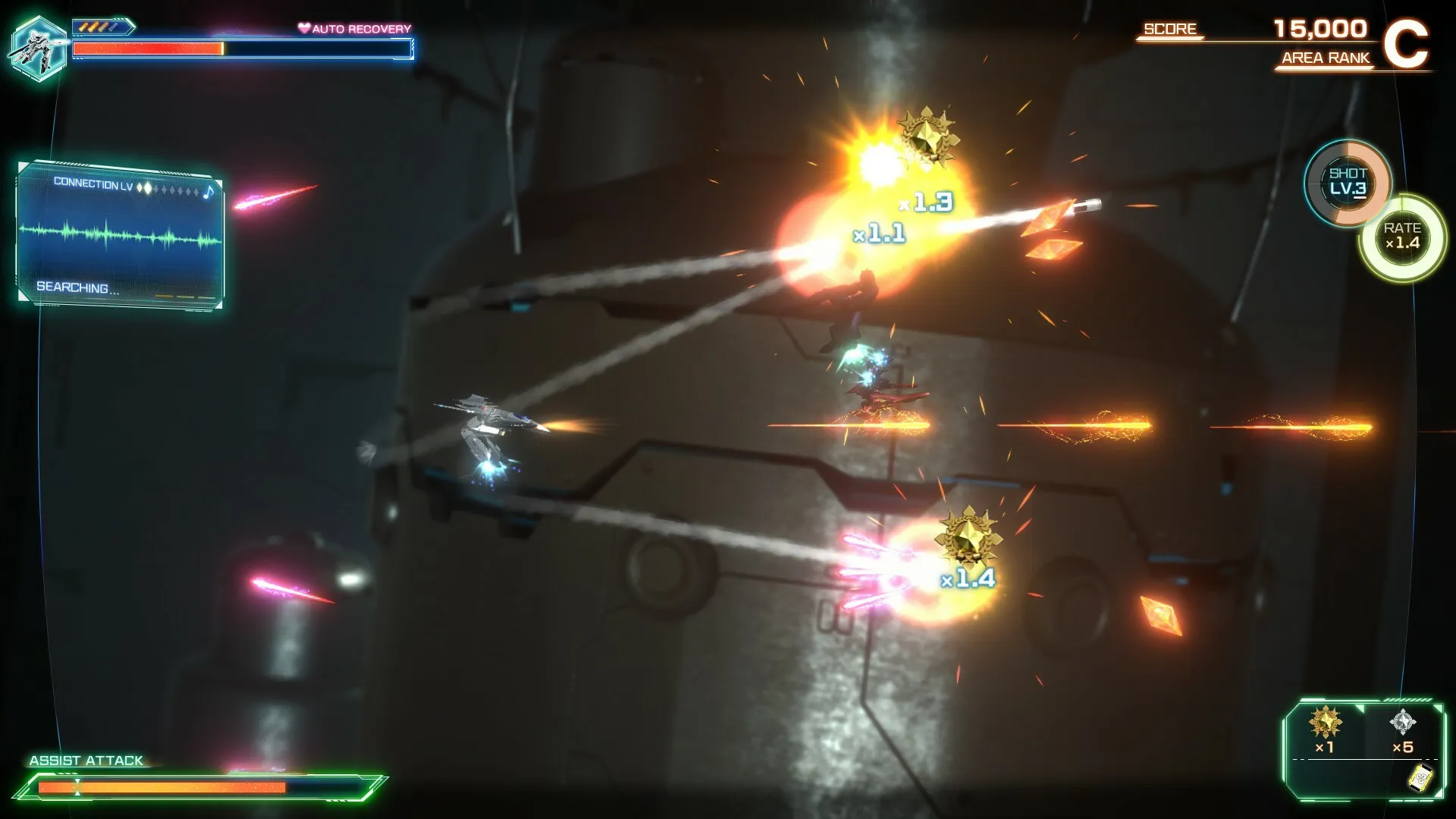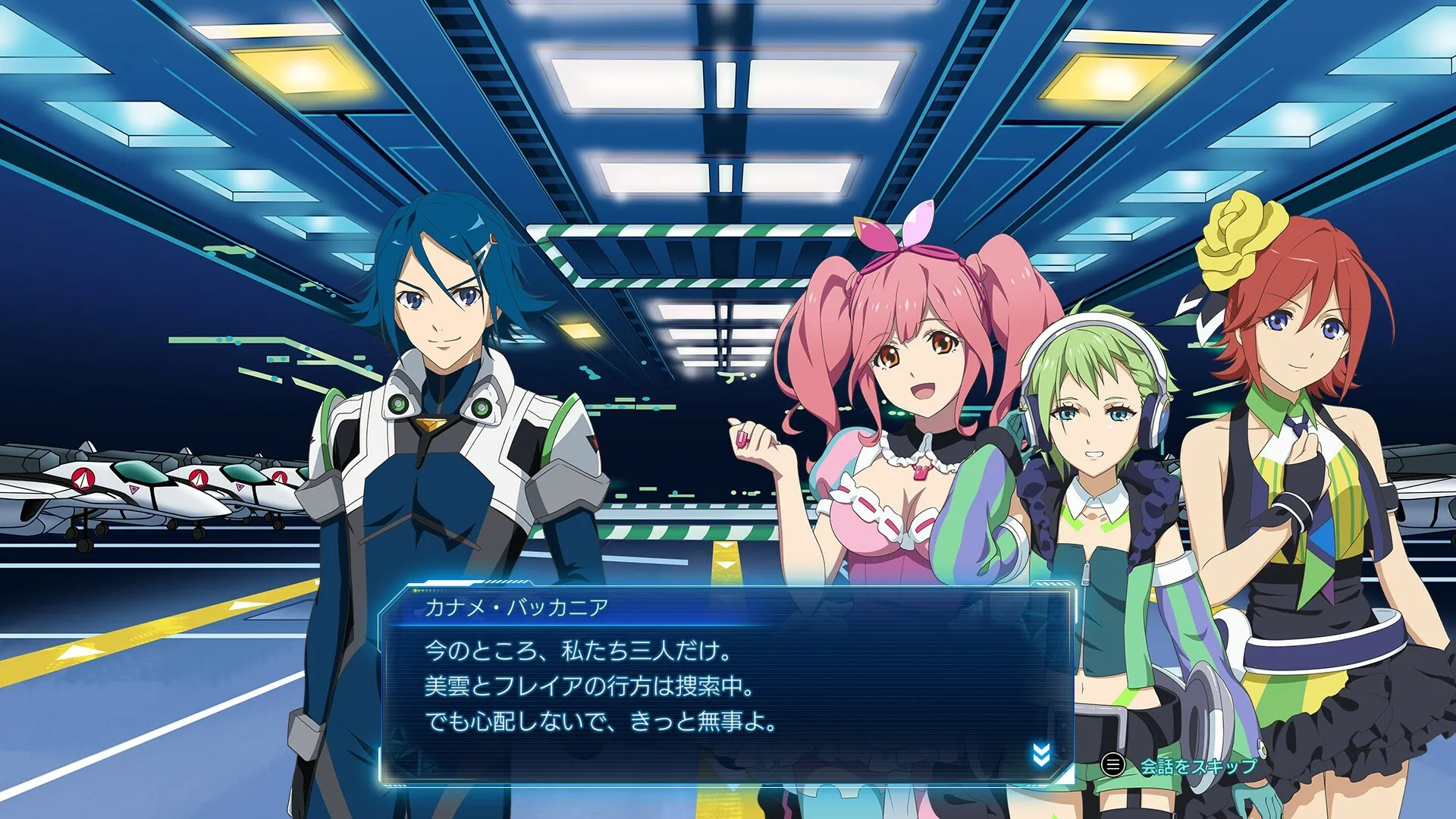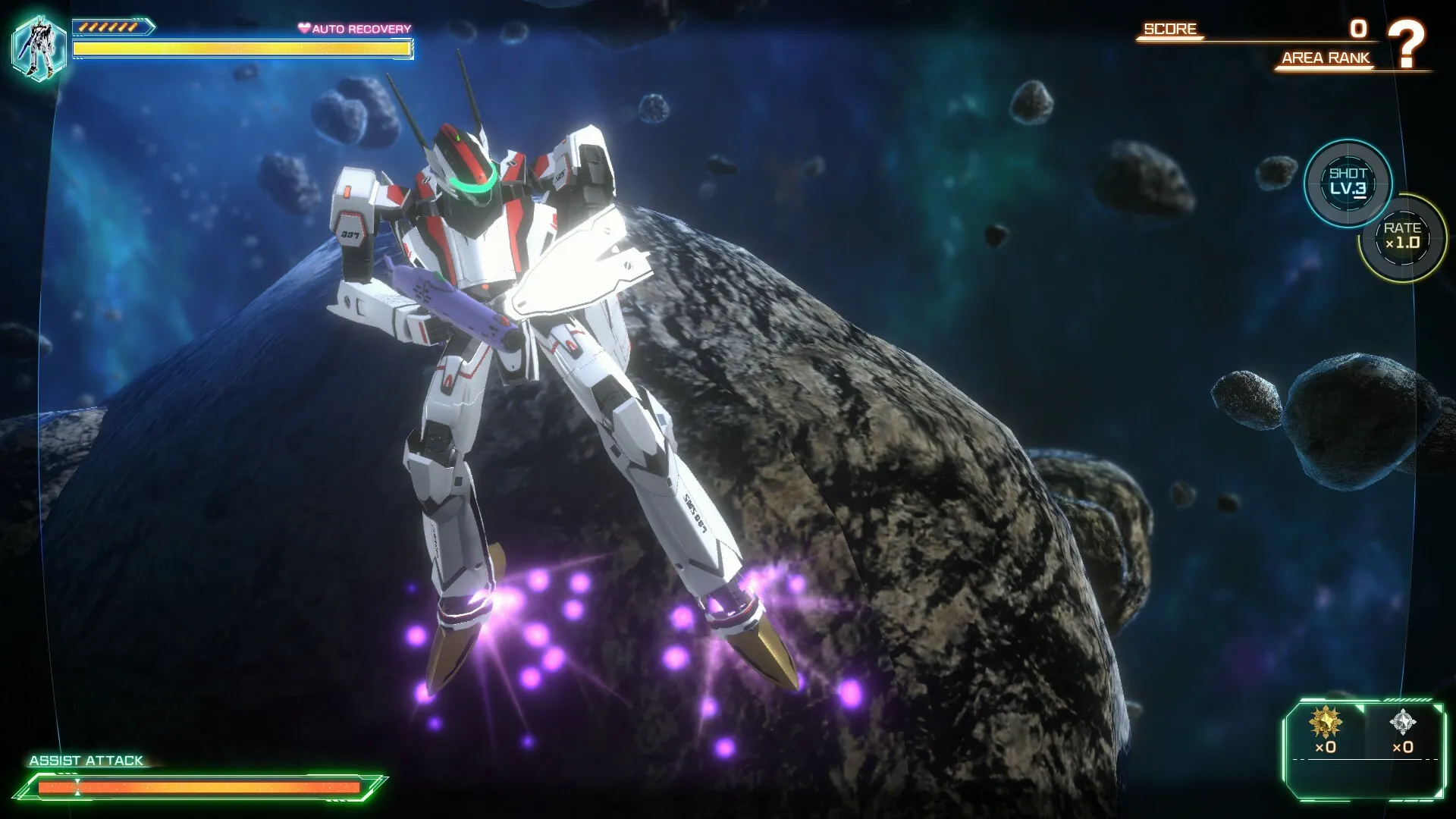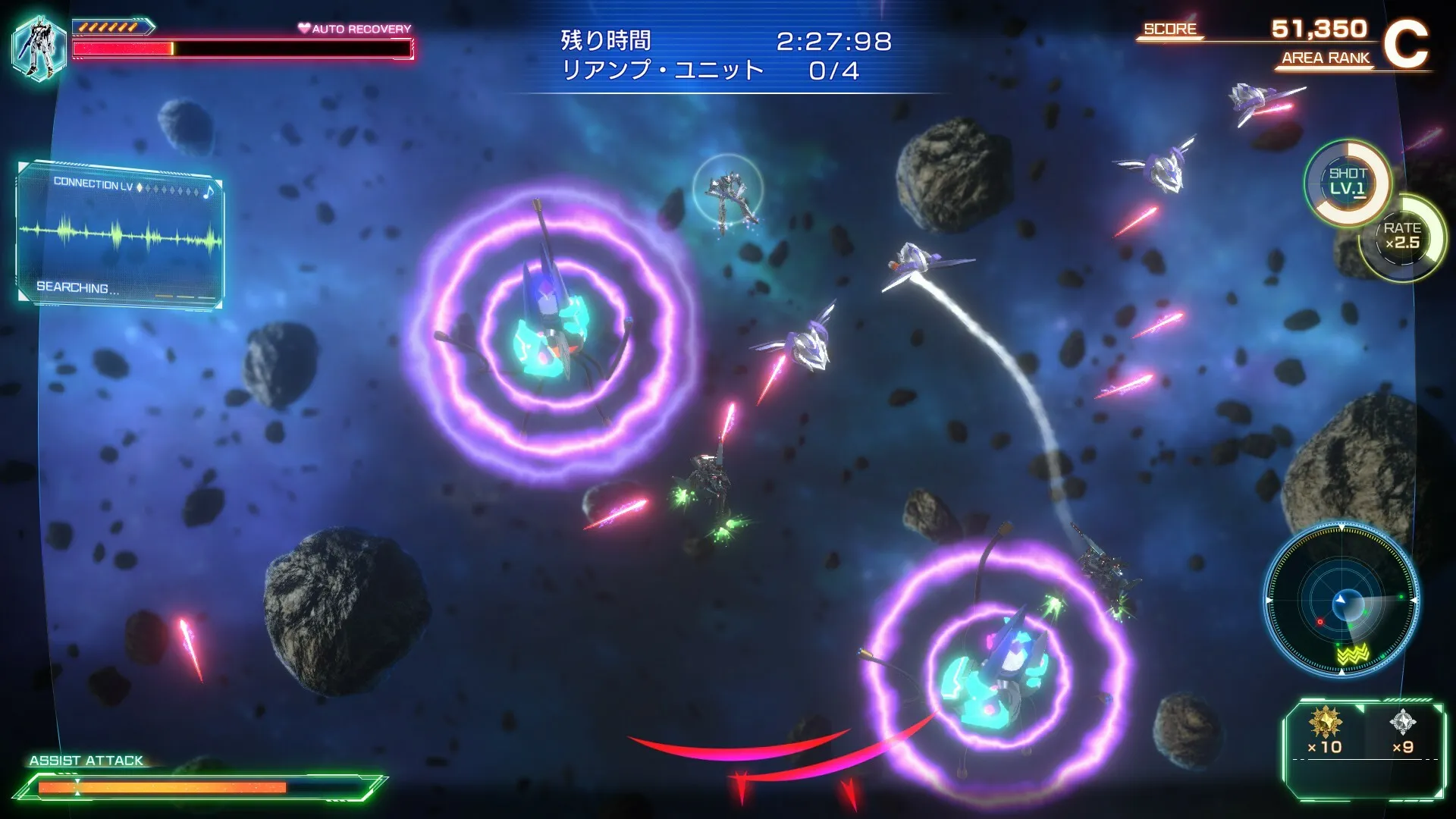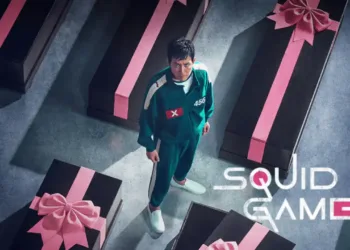Macross – Shooting Insight combines classic shoot ’em up mechanics with an experimental approach to perspectives, showcasing the genre’s development and Macross’s cultural adaptability.
The game transitions between vertical, horizontal, twin-stick, and 3D sequences, a design choice that reflects the international spread of anime and video games, particularly Japanese titles that have gained global recognition.
These perspective shifts offer variety but can occasionally interrupt the gameplay rhythm, embodying the creative tension between honoring gaming traditions and exploring new directions.
The weapon systems in Macross – Shooting Insight, including spread shots, laser beams, and targeted missiles, further emphasize this dynamic. Each attack style presents unique advantages, yet the constraint of not using missile lock-ons and primary weapons simultaneously creates strategic challenges for players.
This mechanical limitation echoes the game’s narrative themes, exploring the interplay between human emotion and technological constraints—illustrating how the game intertwines traditional gameplay elements with experimental design.
The Challenge of Macross – Shooting Insight: Tradition Meets Modern Expectations
Macross – Shooting Insight explores the intricate balance between challenging gameplay mechanics and cultural gaming traditions.
Deeply rooted in arcade shoot ’em up heritage, the game presents a demanding experience reminiscent of classic titles like Gradius or R-Type, where player struggle becomes an integral part of the gaming journey.
The bullet-hell sequences create intense moments, filling the screen with projectiles that test players’ reflexes and spatial awareness. This design philosophy stems from Japanese gaming culture, which traditionally views challenge as a key element of player engagement.
Players can adjust difficulty settings, including health regeneration and skill-based scaling, which addresses the varied skill levels of a global gaming community. The game’s intense pace and enemy swarms create a demanding experience that tests player endurance.
Some players will find satisfaction in overcoming seemingly impossible obstacles, while others might feel overwhelmed by the relentless action. The design walks a delicate line between traditional Japanese arcade challenge and contemporary gaming accessibility, creating a complex experience that speaks to different player expectations.
Visual Design in Macross – Shooting Insight: Aesthetic Choices in a Global Context
Macross – Shooting Insight explores the delicate balance between Japanese anime aesthetics and shoot ’em up gameplay design. The game draws from Macross’s rich visual legacy, creating environments that burst with color and fantastical imagery.
Vibrant backdrops present an immediate challenge, blending dangerously close to enemy projectiles and creating visual complexity that tests player perception. Bright scenes often obscure critical gameplay elements, forcing players to navigate a chaotic visual landscape where survival depends on distinguishing subtle movement patterns.
Mecha boss encounters showcase the game’s visual strengths and limitations. Massive enemy designs capture the epic scale of Macross battles, yet many feel constrained by predictable attack patterns and animations. These encounters reveal a nuanced struggle between spectacular visual representation and mechanical gameplay depth.
The visual language speaks to Macross’s anime roots while challenging players to parse intricate visual information during intense combat sequences. Players must constantly negotiate between appreciating the artistic design and maintaining split-second survival strategies, creating a dynamic visual experience that tests perceptual limits.
Story and Characters in Macross – Shooting Insight: Tying Tradition to Gameplay
Macross – Shooting Insight explores the Macross universe through a gameplay-focused lens, presenting a narrative centered on mecha combat and space battles. Players encounter a straightforward plot involving rescuing songstresses and fighting enemies across space environments.
Storytelling relies primarily on static cutscenes and brief text explanations, which can challenge players unfamiliar with the Macross franchise. Small subtitles during intense action sequences further complicate narrative comprehension, creating an experience that speaks most directly to dedicated Macross enthusiasts.
Character selection introduces strategic variety through different Valkyrie pilots. Each pilot brings distinct weapon systems and combat approaches, ranging from spread shots to concentrated laser beams. These mechanical differences provide gameplay depth, though their connection to the larger narrative remains minimal.
Players without prior Macross knowledge might perceive character choices as purely tactical variations rather than meaningful narrative elements. The gameplay experience highlights the tension between cultural specificity and broader gaming accessibility, inviting players to engage with a distinctly Japanese gaming and storytelling approach.
Replayability and Additional Modes in Macross – Shooting Insight: Navigating Challenge and Progression
Macross – Shooting Insight offers multiple gameplay modes that explore different shooting challenges. The Story mode serves as the primary entry point, with additional modes like Arcade, Ace Battle, and Boss Rush expanding the gameplay experience.
Arcade mode presents escalating enemy waves, testing player endurance and skill. Ace Battle introduces pilot-versus-pilot combat, creating intense one-on-one confrontations. Boss Rush challenges players to defeat major enemies in consecutive battles, demanding precision and strategic thinking.
Game progression centers on collectible power-ups and unlockable content. These items temporarily enhance player capabilities or modify gameplay mechanics. Despite the variety, the reward system feels limited. Collectibles provide minimal impact, and mode transitions lack substantial gameplay variations.
The experience may feel repetitive for players without deep connections to the Macross franchise. The modes ultimately provide different perspectives on the core shooting mechanics, challenging players to master each unique combat scenario through repeated attempts and strategic adaptation.
Music and Audio in Macross – Shooting Insight: A Cultural Discord
Macross – Shooting Insight’s soundtrack creates a complex audio experience that challenges traditional shoot ’em up musical expectations. Rooted in Macross’s anime heritage, the music embraces pop melodies that contrast sharply with the intense gameplay.
Saccharine, melodramatic tunes replace the electronic or rock soundscapes typically associated with shooting games. This musical choice creates a jarring disconnect between the on-screen action and the audio experience, particularly for players expecting high-energy instrumental tracks.
The audio design highlights cultural differences in game sound production. Japanese voice acting with English subtitles emphasizes the game’s anime origins. Sound effects for missiles and weapons meet basic functional requirements but lack the visceral impact players might expect from an intense shooting game.
Weapon and explosion sounds feel muted, failing to match the visual chaos of space battles. The soundtrack and audio elements ultimately communicate a unique cultural approach to game sound design, prioritizing musical tradition over pure gameplay intensity.
Final Thoughts: Macross – Shooting Insight—A Nod to Tradition, but Not Quite Universal
Macross – Shooting Insight explores the intersection between shoot ’em up traditions and the Macross franchise. The game experiments with multiple gameplay perspectives, including vertical, horizontal, twin-stick, and 3D approaches.
These design choices pay homage to classic arcade shooters while attempting to capture the essence of Macross mecha combat. Dedicated Macross fans will recognize familiar characters and mecha designs, triggering moments of nostalgia.
The game struggles with mechanical consistency. Repetitive enemy encounters and limited level designs weaken the initial promise of innovative gameplay. Players encounter a disjointed experience that fails to fully realize its potential.
Narrative elements lean heavily on Macross-specific lore, creating significant barriers for players unfamiliar with the franchise. The soundtrack’s pop music further complicates the combat experience, softening the intensity typically expected in shooting games.
Macross – Shooting Insight speaks most directly to passionate Macross followers and hardcore shooting game enthusiasts. Players seeking a traditional shooting experience may find the game’s approach challenging and unfamiliar. The game offers chaotic moments of excitement, but remains constrained by its specific cultural context and narrow gameplay mechanics.
The Review
MACROSS -Shooting Insight-
Macross - Shooting Insight offers a nostalgic experience for Macross fans, combining classic shoot 'em up mechanics with a rich but sometimes inaccessible narrative. While the game provides solid challenge and replay value through multiple modes, its repetitive design and lack of polish in some gameplay mechanics hinder its broader appeal. The tonal clash between the pop-heavy soundtrack and intense combat further detracts from immersion. Ultimately, the game shines for dedicated fans but falls short in delivering a universally engaging experience.
PROS
- Unique blend of classic shoot 'em up mechanics with Macross elements.
- Engaging character selection with distinct Valkyrie abilities.
CONS
- Story lacks depth and is difficult to follow, especially for non-Macross fans.
- Repetitive level and enemy design detracts from long-term engagement.
- Visual clutter and distracting pop music hinder immersion.
- Some gameplay mechanics feel clumsy, particularly the missile lock-on system.









































